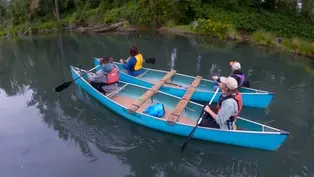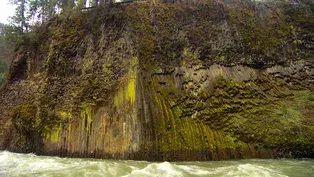Oregon Field Guide
Ginkgo Flow
Clip: Season 35 Episode 5 | 10m 10sVideo has Closed Captions
A geologic road trip explored a mystery that extends from central Washington to the Oregon Coast.
Geologist Nick Zentner (of “Nick on the Rocks” fame) takes us on an entertaining road trip to explore the "ginkgo" lava flow that erupted in central Washington and flowed all the way to the Oregon Coast 16-million years ago.
Problems with Closed Captions? Closed Captioning Feedback
Problems with Closed Captions? Closed Captioning Feedback
Oregon Field Guide is a local public television program presented by OPB
Oregon Field Guide
Ginkgo Flow
Clip: Season 35 Episode 5 | 10m 10sVideo has Closed Captions
Geologist Nick Zentner (of “Nick on the Rocks” fame) takes us on an entertaining road trip to explore the "ginkgo" lava flow that erupted in central Washington and flowed all the way to the Oregon Coast 16-million years ago.
Problems with Closed Captions? Closed Captioning Feedback
How to Watch Oregon Field Guide
Oregon Field Guide is available to stream on pbs.org and the free PBS App, available on iPhone, Apple TV, Android TV, Android smartphones, Amazon Fire TV, Amazon Fire Tablet, Roku, Samsung Smart TV, and Vizio.
Providing Support for PBS.org
Learn Moreabout PBS online sponsorship(seagulls squawking) - I keep hearing about Yaquina Head, and this is it, lighthouse and everything else.
And there's a fascinating lava story.
I'm not sure I believe it, but I think that there's some detail in this lava that will tell us something surprising.
- [Jule] Spend just a few minutes with geologist Nick Zentner, and it's clear this man loves rocks.
- Unbelievable.
This is so fricking cool.
I can't believe it.
- [Jule] What Nick's so excited about is this rock.
It's called the "ginkgo flow," after some ginkgo trees that wound up petrified in the molten lava.
- [Nick] So you see some gold things.
What do they look like?
- It looks like little coppery gems or something.
- Coppery gems.
I like it.
I was hoping that this ginkgo flow would look exactly like this, with these crystals, but I never dreamed it would be this obvious and this beautiful.
I mean, I'm serious.
Like, this is one of the highlight moments for me in the last 35 years.
- [Jule] That's high praise from someone who teaches geology at Central Washington University, hosts a TV series called "Nick on the Rocks."
- And it's more than complicated, it's controversial.
- [Jule] And whose online lecture series gets hundreds of thousands of views.
- I have seen this lava with these crystals in Eastern Washington, and I can show you a spot along the Snake River where there's proof that that's where the eruption was, of this lava, 300 miles inland, almost to Idaho.
Are you interested in going?
- Yeah, let's do it.
(perky music) Traveling across Northern Oregon to Eastern Washington takes you through the geologic wonder known as the Columbia River Basalt Group, a series of lava flows that blanketed the Northwest some 16 million years ago.
It makes up what Nick likes to call the German chocolate cake.
- [Nick] If you think of a German chocolate cake, there's 300 layers in the cake.
And the ginkgo flow is just one of the 300.
(air whooshes) - [Jule] Here in Eastern Washington, the Snake River cuts right through that cake.
Pretty soon we're headed off-road to a place Nick's heard about, but never actually seen.
- I'm hoping when we round this corner we'll see this obvious kind of fin-like wall.
Let's get the drum roll out.
I think that's it.
- That's it.
- I think that's it.
- [Jule] Wow.
- [Nick] Like, how would you describe the shape of those things?
- It looks like a Christmas tree to me, with just the center going up and the branches kind of.
- It kind of does.
So we're looking inside of this German chocolate cake.
All the layers are horizontal.
And then here's this thing cutting up through that's called a feeder dike.
And this is the ginkgo flow.
This is the same one we saw at the Oregon coast.
This is ground zero for that flow.
And to make sure this is the ginkgo.
And I don't even need a hand lens.
- [Jule] There's our orangey crystals.
- [Nick] There's orange crystals.
- [Jule] So that's our telltale puzzle piece.
- Yeah.
I mean, God, that is, I've seen photos of this for like 30 years.
It is kind of a thrill to be here, I got to say.
So if we're here 16.1 million years ago, Jule, this is the crack that opens up Superman style.
(playful elegant music) Here comes this ginkgo magma with the orange crystals inside.
But it gets more interesting than that.
It's not just one point of fire fountaining, but this crack is tens of miles long across Eastern Washington, so to have this curtain of fire.
So you've got this hot syrup that's now starting to flow.
Why is it just basically heading west?
What do you think?
- [Jule] Slope?
- Yes.
- Oh.
- I think we can just say, so most of this isn't rocket science- - It's rock science.
(Jule and Nick laugh) - It's going to try to follow a valley.
The Snake River's right here.
Was the Snake River the thing to follow all the way to the coast?
It's like we're detectives out here.
This is really, like, fun.
But we have a spot where our friend is flowing directly on top of river sand, and there's details in that sand to tell us which river it was.
(perky music) - [Jule] From this remote spot along the Snake River, we make our way down through the Palouse Hills.
A couple hours later, we enter the rocky uplands near Pleasant Valley, Washington, about five miles north of the Oregon border.
Inside this deep canyon, tiny Rock Creek is all but hidden, and gives no hint of the powerful river that once flowed Here.
- Let's go find the bottom of this flow.
The beautiful part about this is the fact that the Columbia River used to be right through here, as opposed to over there.
- Wait, the Columbia River ran through here?
- Oh yeah.
Columbia River.
- [Jule] What?
- Well, let's look for evidence.
Can you put your finger on the cliff that's the very bottom of the ginkgo lava flow and also what is lying below it?
- [Jule] Oh yeah.
Right in here.
- And that is our friend the ginkgo flow.
- [Jule] Wow.
- We've got a moment in time right here where this flow filled up the Columbia Valley and sent the river someplace else.
- What?
Wait, the ginkgo flow came through here and changed the flow of the river?
- Yes, if you fill the entire valley with lava, the river's forced to flow elsewhere.
- [Jule] But it's going to find its way to the coast somehow, huh?
- [Nick] It's going to find its way.
- Yeah.
- [Nick] Let's see if we can find some orange crystals.
- [Jule] Proof's in the puddin'.
- [Nick] Right.
I better come through now.
(Jule laughs) - [Jule] There it is.
Wow, so it's for sure ginkgo.
- [Nick] It's for sure ginkgo.
- [Jule] Super cool.
Having traced the ginkgo through the valley that once held the ancient Columbia, we head into the mighty river's modern course and a state park called Crawford Oaks, near Maryhill.
- And yes, we're standing on top of our friend the ginkgo flow.
If the ginkgo makes it to the ocean, where would you assume the ginkgo is going to get to?
- [Jule] Astoria.
- Astoria, the mouth of the Columbia.
That would be the logical thought.
- Yeah.
- But then the branch of this flow is going to get to Yaquina Head.
- And which direction is Yaquina?
- [Nick] Well, let's get up in the air.
Yaquina Head in the Newport, Oregon area is, essentially, as the crow flies, that way, where Mount Hood is today.
- [Jule] You might have to explain why Mount Hood's sitting there.
- (laughs) Well, Mount Hood is a giant, beautiful mountain, but it's a baby.
It's less than 1 million years old.
And remember, this is a 16-million-year-old lava flow.
So it just happens to be that today, Mount Hood is this cherry on top of this old, buried, fossilized Columbia River Valley.
Isn't that cool?
- [Jule] That's amazing.
- And there's a place in the Willamette Valley where there is ginkgo flow and a major waterfall coming over it at a secret spot.
(Jule laughs) - [Jule] Out of the rocky and dramatic Columbia River Gorge, we drive southwest into the verdant green of the Willamette Valley.
Wow, look at all this snow.
Sort of.
This is North Falls at Silver Falls State Park, near Silverton.
Here, flows of Columbia River basalt form sturdy cliffs for a series of thrilling waterfalls.
It's another spot where the ginkgo likely flowed right into the course of an ancient river.
- Maybe we have to go back behind the waterfall to see it.
So the question is, is this the sandstone?
I think it is.
- Wow.
- I think it is.
- [Jule] Oh, look at that.
That's sandy.
- Yeah, it's the sand now.
So we've got this resistant ginkgo flow that's making this ledge above us.
Oh God, this is amazing.
So if this is Columbia River sand, great.
If it's not Columbia River sand, and it's a different river that was cross-cutting through south of Portland, that's fine too.
It doesn't matter.
What matters is that this is our same ginkgo flow.
And as much as I'd like to break this thing open and look for orange crystals, I know we're in a state park.
It's probably not a good move, right?
But this is the ginkgo flow.
- [Jule] With that, we drive the last 100 miles to Newport and the place we started, Yaquina Head.
- Pretty nice!
- This time we're top side.
So the ginkgo flow ends here.
- Yes.
But it's kind of only the beginning, believe it or not.
Because there's evidence that when it was liquid, it dug into the ocean sand and re-erupted a little bit further.
- So we've got ginkgo flow part two, potentially.
- There we go.
I like it.
- The underwater edition.
- The underwater edition.
Now you're thinking.
Yeah, I like that.
- [Jule] You're leaving us with a cliffhanger.
- [Nick] Yeah, totally.
(Jule laughs) (seagulls squawking) (no audio) - Great people just doing their thing in their own Northwesty way.
We love bringing you stories like this.
Support what you love.
opb.org/video.
Video has Closed Captions
Exploring the surprising natural oasis of Portland's Columbia slough. (8m 59s)
Video has Closed Captions
The North Umpqua River is lovely in the rain. (1m 52s)
Providing Support for PBS.org
Learn Moreabout PBS online sponsorshipOregon Field Guide is a local public television program presented by OPB













